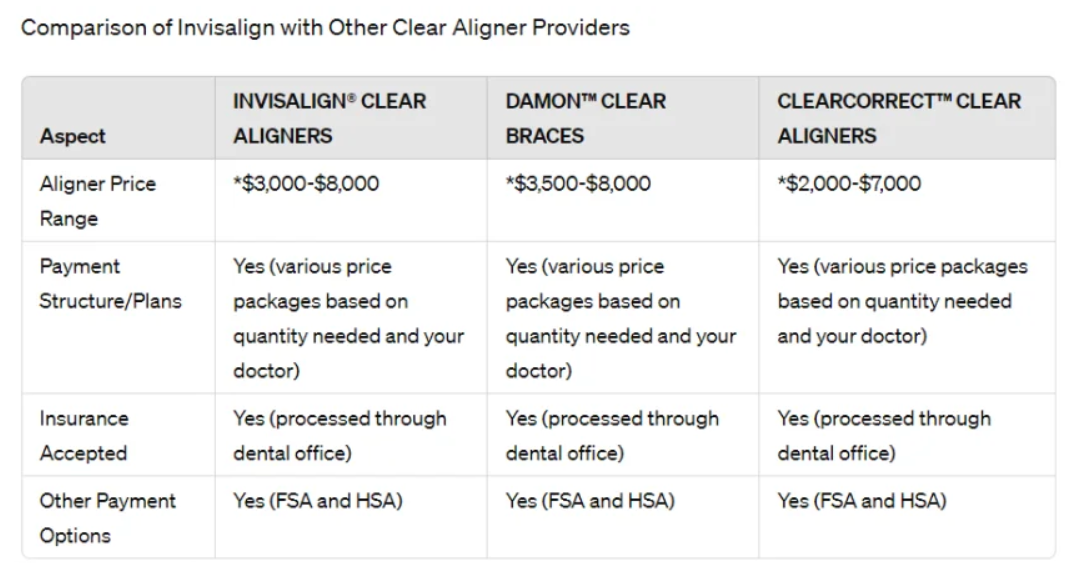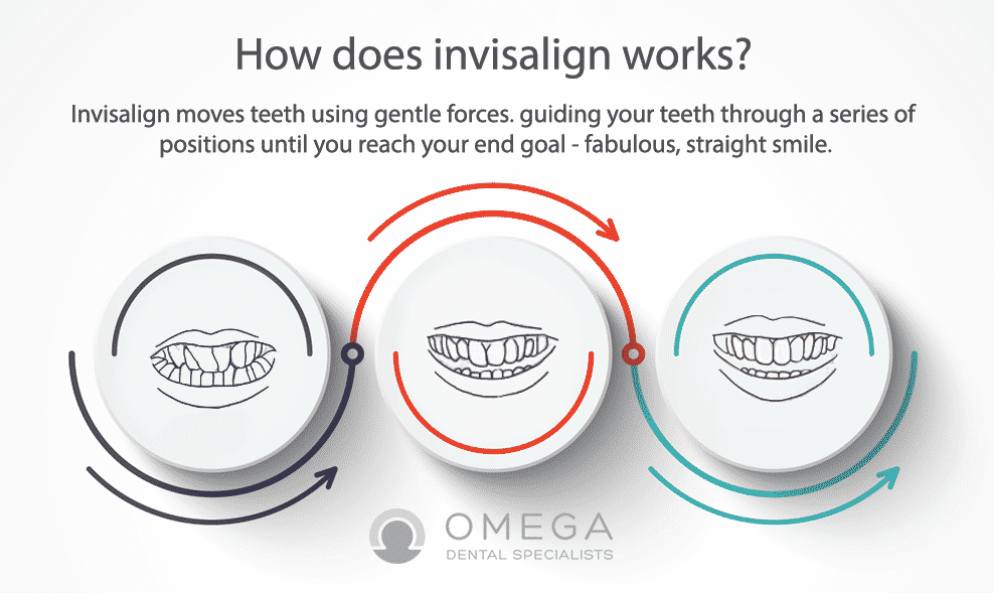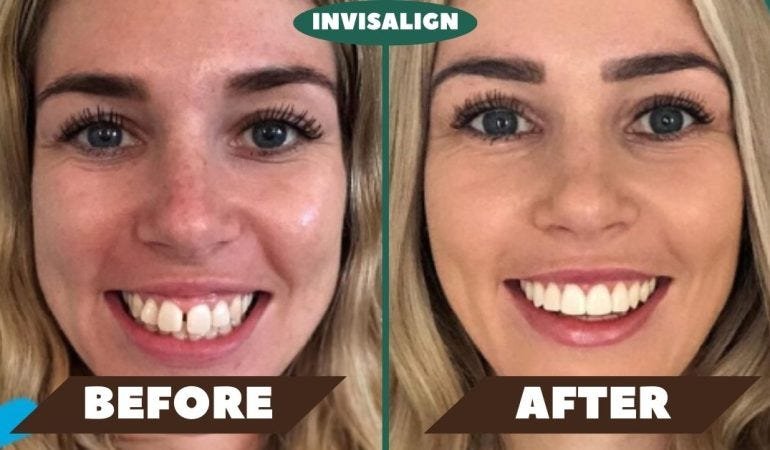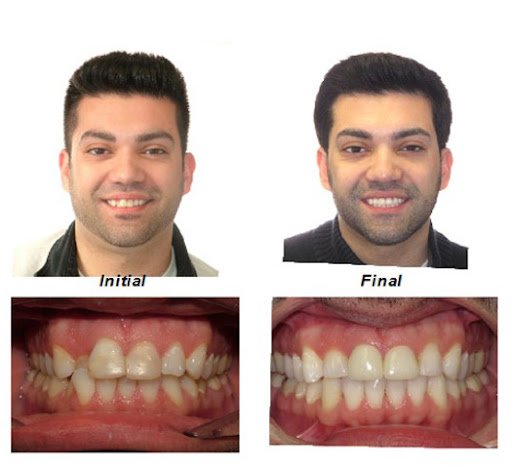The cost of invisalign aligners
The cost of invisalign aligners typically falls within the range of $3,000 to $8,000. The exact amount you’ll pay depends on your individual circumstances and the extent of your dental issues. For minor adjustments, expect to pay around $3,000 to $4,000, while more common alignment corrections typically range from $5,000 to $6,000. However, for more severe cases, the cost can reach up to $8,000. It’s worth noting that there are also alternative Invisalign treatments available online for those seeking cost-effective options.
The invisalign experience

Invisalign aligners offer unparalleled precision and accuracy throughout your treatment journey, largely due to the involvement of your local dental professional. Similar to traditional braces, Invisalign treatment ensures remarkable precision but with the added advantage of cutting-edge technology and products. Notably, these aligners are exceptionally clear, almost imperceptible even upon close inspection. Moreover, the benefits extend to the retainers, which are custom-manufactured based on your teeth’s alignment post-treatment, ensuring optimal retention for a lifelong straight smile.
While the pricing may exceed that of online aligner providers, Invisalign guarantees solid results. While online aligners can be effective and safe, Invisalign’s assurance of safety and effectiveness is further bolstered by the oversight of dental professionals who leverage the company’s digital technology and extensive patent portfolio to ensure accurate treatment.
In terms of comfort, Invisalign aligners outshine many other brands, offering reliable performance through their innovative design. With over two decades of technological advancements and experience since its establishment in 1997, Invisalign provides a level of assurance that mitigates concerns about subpar or incomplete results, although other aligner options can still yield satisfactory outcomes. Ultimately, opting for Invisalign aligners minimizes the risk of treatment failure, providing peace of mind throughout your orthodontic journey.
Treatment duration
The duration of your custom Invisalign aligner treatment typically spans between 12 to 18 months, with aligners worn for two-week intervals. However, there may be instances where one-week wear times are prescribed, albeit less frequently.
Similar to the pricing structure, treatment duration is contingent upon the specific type and severity of your orthodontic needs, as well as individualized factors. Your healthcare provider will tailor a treatment plan accordingly.
Availability
Invisalign aligners are accessible in the United States and numerous other countries. For further information, please visit www.invisalign.com.

How does invisalign work?
Invisalign operates through custom-made aligners tailored to gradually adjust your teeth. These aligners utilize SmartTrack® material for enhanced comfort and easier handling. Additionally, they incorporate SmartForce Aligner Activation® technology to optimize tooth movements and enhance predictability. By applying gentle yet consistent force, they aim to minimize the pain and swelling often associated with some online aligner brands. Each aligner is typically worn for two weeks, although individual circumstances may necessitate different durations, such as one day or three.
Your treatment duration with Invisalign will be individually tailored, typically spanning from 12 to 18 months, depending on your specific needs. Results become evident fairly promptly, and the adjustment process continues until treatment reaches completion.
Invisalign offers four distinct treatment options, each tailored to address varying dental requirements:
- Invisalign full: Ideal for complex cases necessitating a comprehensive set of aligners.
- Invisalign teen: Specifically crafted for adolescents whose mouths are still in the developmental stage, providing additional aligners to accommodate growth.
- Invisalign lite: A cost-effective alternative suitable for simpler cases requiring fewer alignment trays.
- Invisalign i7: Geared towards achieving rapid results, specifically targeting minor dental issues involving only a few teeth.
One of the primary advantages of Invisalign is the personalized oversight provided by a local dental professional, who continually monitors progress and can make necessary adjustments to your treatment plan as needed. This may involve modifying aligners or adjusting treatment duration. To provide Invisalign aligners, dentists must undergo certification and training. Regular progress checks and the acquisition of new clear aligners occur during visits to your dental professional every 6 to 8 weeks.

Navigating invisalign treatment journey
The typical wear duration for each set of aligners is usually one to two weeks. Upon starting a new set, it’s normal to experience some discomfort for the first few days as your teeth adjust to their new position. To maintain cleanliness and optimal hygiene, it’s important to rinse and gently brush your aligners with your toothbrush every night, which also helps preserve their appearance. Additionally, a weekly cleaning with the Invisalign cleaning system is recommended to ensure thorough maintenance.
Invisalign extends its treatment offerings to young children through the Invisalign First program, which is specifically designed to address crowding and spacing issues during Phase 1 orthodontic treatment. Phase 1 occurs when some or all baby teeth are present, but permanent teeth have yet to erupt, aiming to prevent future orthodontic complications.
Following the completion of your aligner treatment, your dentist will arrange for retainers to maintain your teeth in their new alignment. During this process, your dentist will discuss various retainer options with you, and your aligners will be shipped directly to their office.
Invisalign treatment duration: my step-by-step journey
Invisalign stands out as a premium aligner provider, offering clear and comfortable aligners designed to seamlessly integrate into your daily routine. While my treatment spanned a mere eight months due to minor crowding requiring only a touch-up, the typical duration falls within the range of 12 to 18 months. Below, I’ll outline my journey through the aligner treatment process.
Step 1: Online assessment
I completed the Invisalign Smile Assessment questionnaire to determine the suitability of Invisalign aligners for my needs. The questionnaire inquired about my age group, teen, parent, or adult and prompted me to specify the dental issue I was experiencing, providing illustrative examples through images. Following this, it offered the option to schedule a consultation or confirm an existing appointment. Subsequently, I received an email confirming my candidacy and outlining the subsequent steps.
Step 2: Locating a dental professional in my vicinity
Utilizing the website’s search feature, I located an Invisalign dentist within my locality. This ensured that my orthodontist or dentist possessed Invisalign certification and training. Moreover, it spared me the inconvenience of individually contacting numerous local dental practices to ascertain their provision of Invisalign aligners and proficiency in administering them.
Step 3: Booking and attend the complimentary consultation at the dental office
I arranged for my complimentary consultation, during which the dentist elaborated on the Invisalign process and presented various aligner options. Additionally, we scheduled an appointment for the aligner preparation session, wherein my teeth were assessed, and the requisite measures for obtaining Invisalign aligners were outlined.
Step 4: Aligner preparation appointment
During my appointment, the dentist conducted a digital scan of my teeth, performed necessary X-rays to ensure suitability for aligner use, and captured the required photos as per Invisalign’s guidelines for aligner creation. We also discussed the anticipated outcomes for my smile with Invisalign treatment. Subsequently, we scheduled another appointment to review my aligner package post-analysis by Align Technology, Inc.
Following the appointment, all documentation and data were transmitted to Align Technology, the manufacturer of Invisalign aligners. The dentist assured me of reviewing the details sent back by Align Technology to ensure alignment with my treatment needs. Utilizing digital technology, I was able to visualize incremental, animated images showcasing the anticipated outcomes of my treatment. These step-by-step simulations provided a comprehensive understanding of the proposed aligner treatment plan. After witnessing the potential results through Invisalign® SmileView™, I decided to proceed with ordering aligners.
Step 5: Payment processing for aligner treatment
During the appointment for processing and ordering, I discussed payment options with the dentist. After careful consideration, I opted to finalize the payment for my Invisalign aligner treatment. I utilized my Health Savings Account (HSA) to cover a significant portion of the costs, processed my dental insurance to determine coverage, and arranged a payment plan for the remaining balance.
Subsequently, the dentist proceeded to place the order for my aligners. I was informed that I would be contacted once the aligners arrived.
Step 6: Collecting my invisalign aligners
Following a call from the dentist notifying me of the arrival of my personalized Invisalign aligners, I visited the office. During this visit, the dentist provided comprehensive treatment instructions and examined the initial set of aligners, which I then installed over my teeth. After ensuring everything was in order, I left the office with my aligners ready to begin my treatment journey.
Step 7: Six-week checkups
Regular six-week intervals require visits to the dentist for a thorough review and assessment of alignment progress. Should any issues arise, the dentist will devise a tailored plan of action accordingly. Conversely, if progress is deemed satisfactory and on target, the next six-week checkup will be scheduled during the visit.
Step 8: Final checkup
Upon completion of the final aligner treatment, the doctor reviewed the results and checked the condition of my teeth. All looked good. I could choose removable Vivera® clear retainers from Invisalign, fixed/permanent retainers that use wire across the back side of the teeth, or Hawley retainers that have an acrylic arch plus metal wires that hold the teeth in place. He recommended the Vivera aligners based on my situation. Those retainers are made of the same material as the Invisalign retainers and carry the same clear characteristics.
Invisalign transformations: before and after treatment

With its establishment in 1997, Invisalign boasts considerable experience and cutting-edge technological advancements, resulting in the production of well-fitting, adaptable, and exceptionally clear aligners and retainers. This has contributed to the satisfaction of numerous patients, as evidenced by their extensive clientele exceeding 6 million individuals. As the entire process is overseen by a local Invisalign-certified dentist, patients can rest assured of achieving favorable outcomes.
Occasionally, some individuals may find that their teeth are not fully aligned upon completing the program. While this occurrence is normal, it is relatively uncommon. In such cases, Invisalign offers your dentist up to three additional aligner treatment plans at no additional cost, ensuring optimal alignment without any financial burden. This added flexibility is a compelling reason why many patients, including parents considering treatment for their children, opt for Invisalign.
Throughout the treatment intervals, patients can witness their progress unfold, mirroring the transformations showcased by fellow Invisalign patients. By the conclusion of the treatment program, patients can expect their teeth to exhibit the same remarkable improvement depicted in the images above.

Invisalign tips
Before embarking on Invisalign treatment, it’s crucial to make financial arrangements by checking your FSA or HSA account and assessing your insurance coverage. Additionally, determine payment options for any remaining balance, as these may vary depending on your dental provider. Discussing these options with your dentist is essential for clarity.
Beyond financial considerations, maintaining the cleanliness of your Invisalign aligners is paramount. Daily rinsing helps prevent the accumulation of bacteria and stains, safeguarding your teeth and gums and preserving the overall appearance of the aligners.
Obtaining your invisalign aligners from home
Every registered dentist is required by Invisalign to place orders for aligners through their online accounts. Consequently, all aligners are shipped directly to your dentist. Although Invisalign typically dispatches your entire order at once, adjustments to your treatment plan can still be made by your dentist as needed. While some dentists may retain your aligners and dispense them according to schedule, most provide the entire set at once. Ultimately, while you receive your invisible teeth aligners at home, you initially collect them from your local dental office.
Conclusion
Invisalign stands as a leading choice in orthodontic treatment, renowned for its effectiveness, comfort, and discretion. With over 6 million satisfied users worldwide, its reputation for transforming smiles is unmatched.
From personalized treatment plans to continuous oversight by local dental professionals, Invisalign ensures tailored solutions for each patient’s needs. Its commitment to innovation and patient satisfaction shines through at every step of the journey.
In summary, Invisalign aligners not only straighten smiles but also redefine the orthodontic experience, offering a seamless blend of technology and comfort. With Invisalign, achieving a confident smile has never been easier.
FAQ
Is Invisalign painful?
Invisalign aligners can cause some pain, especially during the first few days with each new aligner. Once the aligner starts to shift the teeth, the discomfort begins to lessen. Each new retainer is adjusted to shift the teeth about 0.2 mm so the “push” in the beginning can lead to some degree of pain and discomfort. In addition, poor teeth and aligner maintenance can cause pain from bacteria accumulation and even decay of the tooth or root.
Can you drink with invisalign?
Yes, you can drink liquids while wearing Invisalign aligners. For drinks that cause heavy staining, it is recommended that you temporarily remove your aligners to help keep them looking their best.
Can invisalign widen my smile?
Invisalign doesn’t technically widen your smile. It restructures the look of your smile to make it appear wider. Generally speaking, crowded teeth are the issue that reduces your smile’s width. As your teeth begin to spread out and realign, your smile will appear wider.
Can invisalign fix an overbite?
Yes, Invisalign can fix an overbite as long as it is not severe. It gradually moves the teeth until the desired look is achieved. It can take anywhere between 12 and 18 months.
Can invisalign fix gaps?
Yes, Invisalign can fix gaps in your teeth, small or wide. It just takes longer to move the teeth for severe cases. Invisalign moves teeth at a rate of about 0.2 mm for each aligner.
Author of this blog post:
Anye Tchouli Calne Forkob Linkedin

Anye Tchouli Calne Forkob is a medical student at the University of Buea and a Health Sciences student at the University of the People. He is passionate about community health outreach, self-care, and healthy lifestyle and aims to bridge the knowledge gap in the health sector.
Published by Toothhealth Team



